68k Macintosh
The Computer for the Rest of Us
68k Macintosh
The Computer for the Rest of Us
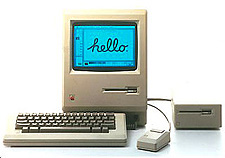
The one that started it all. Case design was identical in the 128k and 512k Mac models, with a 9″ black & white screen, small keyboard, separate numeric keypad, and a 3.5″ 400k floppy drive; the 512k “Fat Mac” added badly needed RAM. System Software ran off one floppy, and a second external drive (if you were lucky) held your program or data files – swapping floppies was a way of life for Mac pioneers. The original Mac System Software did not yet have a Shut Down command, just Eject Disk and the power switch on the back. But Windows and Menus were there, the Mouse got introduced to the masses, and the classic Calculator desk accessory survived virtually unchanged all the way to Mac OS 9! The GUI had arrived.
At the VMM a 512k traces the early evolution of the Mac OS with boot floppies for Systems 1-5. VMM TV: Apple “1984” Commercial

Apple’s longest selling 68k Macintosh model (1986-1990), the Mac Plus brought SCSI support, a full keyboard, a significantly larger RAM capacity (4MB) and an external hard drive option – yay, the end of floppy swapping! The Plus became a big business seller, and teamed with the original Apple LaserWriter and Adobe PostScript fonts offered a reasonably priced entry into the new world of Desktop Publishing. The Mac’s role in defining this industry had an indelible effect on publishing and the dissemination of information worldwide.
The VMM Mac Plus runs System 6.0.8 and is loaded with copies of Apple’s original MacPaint, MacWrite and MacDraw, some classic Mac games, and helps read old floppy disks for Oakbog’s Mac file transfer services.
VMM Blog: Vintage Mac Museum Workhorse – Mac Plus
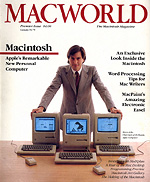 |
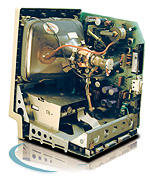 |
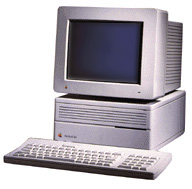
The Mac II marked the introduction of color screens and expandable systems – with fans (an objection of His Stevedom during the First Jobs Dynasty). The Mac’s use in business, live performances and the creative arts exploded with the Mac II line. The IIci was the most popular of the series, using a smaller, easy to service 3-slot case sized for cubicle desktops; the IIfx was the 6 slot champ with its “wicked fast” 40MHz 68030. And who can forget the clarity of the Apple 13″ RGB monitor? So what if it weighed 50 pounds and doubled as a space heater, the thing was built like a tank!
The Museum Mac IIci runs System 7.1 and has copies of two seminal early web applications, NCSA Mosaic (the first graphical web browser) and Netscape 1.1N. Let the Browser Wars commence! VMM TV: Dinosaurs
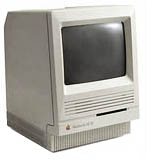
The SE/30 was the compact Mac on steroids. A 68030 processor gave this machine the processing power of a Mac IIx, a PDS expansion slot allowed for ethernet capabilities, and it had a power supply that couldn’t be beat – to this day there are still SE/30s running in dusty closets around the world. This machine powered many home MIDI studios running MOTU Performer and Opcode Vision software, and often found a second life as a back room fileserver (just like your hand-me-down iMac).
The VMM SE/30 runs System 7.5.5 and can go wireless using an ethernet-to-WiFi bridge! There’s nothing like surfing the ‘net in black & white with Netscape 2.0 to impress the friends and neighbors!
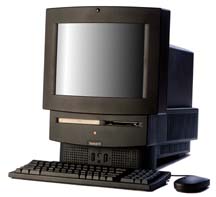
A black Mac! The MacTV was a limited edition Performa 520 all-in one, clad in a black case and including a TV tuner card. A Control Panel or supplied infrared remote control switched the whole screen between the Mac’s desktop, the TV tuner or a composite video input – no video-in-a-window on this puppy. Nothing the Performa couldn’t do, but Apple offered very few black machines during this period (or since) in North America (they were more popular in Europe), and it looked very cool! Unfortunately it was ahead of its time, and underwhelming performance plus slow sales led to a short lifespan. It has since become a desirable collector’s model.
At the VMM a MacTV is connected to a DVD player running a loop of Apple TV commercials and demos from throughout Apple’s history.
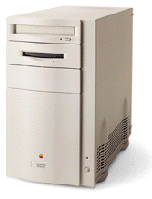
The Motorola 68040 processor was the powerhouse of the 68k era, and the Quadra series (replacing the Mac II) was named after this fourth-generation chip. The 840AV was the ultimate 68k Macintosh: 40MHz ‘040 processor, fastest NuBus architecture, 16 bit stereo sound with video input/output, the ARTA chip (Apple Real Time Architecture – another fine technology doomed before it’s time), and a sporty minitower case. This machine was faster for many tasks than the first generation PowerPC machines introduced a year later, and Quadras dominated the professional audio and video production industries in the early 1990s.
At the Museum a Quadra 840AV is running Mac OS 8.1 and showcasing Apple’s legendary “1984” commercial on its AudioVision monitor. It also serves as an Ethernet-to-LocalTalk bridge for the Mac Plus with old Mac file transfer projects.
VMM TV: The Quadra Revolution
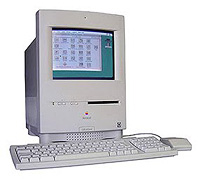
Putting a color screen into the original compact Mac case always seemed an obvious step, although by the time this model was released the Mac II line had been out for several years and Apple was beginning to ship faster 68040 based systems. The 16MHz 68030 processor provided pokey performance, but the Color Classic was cute, portable and inexpensive. It became relatively popular, particulary in Japan where space was at a premium, and a 33MHz Color Classic II with stereo sound was released only for that market.
A working Color Classic is a new edition to the VMM, and sits proudly on top of my office bookshelf running the After Dark “Fish” screensaver. Which is much easier than setting up my actual Macquarium…
VMM Blog: Resurrecting a Macintosh Color Classic